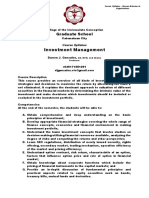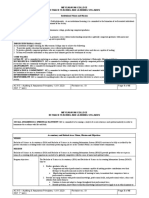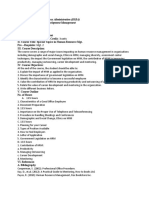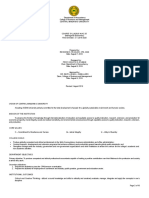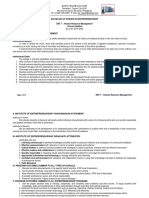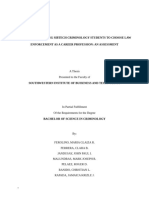The Influence and Impact of Long-Term and Short-Term Contracts On Employee Behavior - A Study of Nigeria'S Banking Industry
The Influence and Impact of Long-Term and Short-Term Contracts On Employee Behavior - A Study of Nigeria'S Banking Industry
Uploaded by
Hychell Mae Ramos DerepasCopyright:
Available Formats
The Influence and Impact of Long-Term and Short-Term Contracts On Employee Behavior - A Study of Nigeria'S Banking Industry
The Influence and Impact of Long-Term and Short-Term Contracts On Employee Behavior - A Study of Nigeria'S Banking Industry
Uploaded by
Hychell Mae Ramos DerepasOriginal Title
Copyright
Available Formats
Share this document
Did you find this document useful?
Is this content inappropriate?
Copyright:
Available Formats
The Influence and Impact of Long-Term and Short-Term Contracts On Employee Behavior - A Study of Nigeria'S Banking Industry
The Influence and Impact of Long-Term and Short-Term Contracts On Employee Behavior - A Study of Nigeria'S Banking Industry
Uploaded by
Hychell Mae Ramos DerepasCopyright:
Available Formats
International Journal of Economics, Commerce and Management
United Kingdom Vol. VI, Issue 12 (addendum) December 2018
http://ijecm.co.uk/ ISSN 2348 0386
THE INFLUENCE AND IMPACT OF LONG-TERM AND
SHORT-TERM CONTRACTS ON EMPLOYEE BEHAVIOR
- A STUDY OF NIGERIA’S BANKING INDUSTRY
Anyim Godfrey
Niagara University, Ontario, Canada
godfreya2002us@yahoo.com
Abstract
The human resources strategies and employment arrangements adopted by banks within the
Nigerian Banking sector have undergone several changes over the years. These changes have
potential negative impacts on employee behavior over time. Research about employment
contract of banking employees in developing countries like Nigeria is not readily available. The
main goal of this research was to evaluate the existing relationship between short-term and
long-term contracts and employee behavior. Data were analyzed from 600 (n) banking staff
within Nigeria’s 77,600 (N) bank employees. Correlation analysis was performed to determine
the existing relationship between short-term and long-term contracts and the behavior of the
employee with reference to their level of job satisfaction. The study established a negative
correlation between type of contract and employee behavior. There were significant differences
between the type of contract and the employee behavior. Findings revealed that employees
working under long-term contracts experience higher levels of job satisfaction and therefore
exhibit more positive behavior than employees on short-term contracts.
Keywords: Employment contract, long-term contract, short-term contract, employee behavior
INTRODUCTION
This topic investigates the influence and the impact of short-term and long-term contract
employment in an organization. The study focused on Nigeria's banking sector which has
significant number of employees on short-term contract employment. As indicated by Okoye
and Aderibigbe (2014), the past four decades have been characterized by a global upsurge in
Licensed under Creative Common Page 1
© Godfrey
the number of organizations that employ workers in short-term basis. This has been ascribed to
economic instability and uncertainty (Jackson, Schuler and Jiang, 2014). Further, the situation
can be attributed to the increasing global competition and the need to minimize the cost of doing
business.
Background of the Study
Employment on short-term contract is perceived to be as a result of persistent changes in the
working structure across the world and has turned into an important factor in the last four
decades as long-term contracts seem to be declining in the different industries (Okoye and
Aderibigbe (2014). Although contract employment has been around for a while, the influences
and impacts on employees and organizations are yet to be fully established because of the
many associated factors that can affect the outcomes.
The labour market has been experiencing a transitional period regarding the type of
employment contract, shifting from a long-term contract to nonstandard short-term contract
arrangements. Long-term contract arrangements have been the standard in industrialized
nations for a significant part of the last century and formed the framework for the development
of labor legislations (Cappelli and Keller, 2013). However, in the 1970s, globalization of trade
put more pressure on business organizations to increase their profits and compelled them to
determine ways to introduce employment flexibility leading to the adoption of non-standard
short-term contracts (Cappelli and Keller, 2013). Pedulla (2013) indicates that a number of
organizations shifted from long-term contract employments to short-term contracts to minimize
on costs and benefits provided to long-term workers (permanent employees). Some
organizations use short-term contracts as a probation period to preview potential workers who
meet or otherwise fail to meet the performance criteria of the organization and to offer long-term
contracts to desired individuals. Other organizations may use this period in their advantage to
develop a meaningful employer-staff relationship. (Pedula, 2013).
At times, the yearning for long-term contracts originates from an observation that their
salary source is less steady; short term workers would also like to be seen as low risk
investments by lenders. While short-term contracts are gradually taking up a higher percentage
of employment arrangement and replacing long-term employment, research has determined the
consequence of this shift could be as a result of government and employers in industrialized
countries pushing for more flexible labour conditions to better business profits (Spreitzer,
Cameron and Garrett, 2017). At the same time, the short-term labour market could be pushing
for its establishment and liberty from restrictions (Okoye and Aderibigbe, 2014).
Licensed under Creative Common Page 2
International Journal of Economics, Commerce and Management, United Kingdom
In this report, the nature of the contract of employment is used to develop a framework for
understanding employee behavior. Employee job satisfaction is defined as “persistent feelings
towards discriminable aspects of the job situation that are thought to be associated with
perceived differences between what is expected and what is experienced in relation to the
alternatives available in given situation” (Smith, Kendall and Hulin 1969, cited in Ntisa, Dhurup,
and Joubert, 2016) . Therefore, job satisfaction mirrors an employee’s behavior in relation to
their assessment of their experience and level of their satisfaction or dissatisfaction with the
nature of the contracts of employment. To determine the influence and impact of the contract
type on the behaviors of staff with regard to job satisfaction, would require a combination of
complex factors. Wilkin (2013) asserts that the predictors of job satisfaction are compensation,
job security, working conditions, possibility of growth, and promotion and workload. These
variables may be favorable to the employee depending on the nature of the contract. If the
impact is favorable, the level of job satisfaction is expected to be positive while unfavorable
impacts are expected to produce a negative correlation. This argument is supported by
Maslow’s hierarchy of need that indicates that an employee whose needs are met is likely to
experience job satisfaction (Niemela and Kim, 2014).
Problem Statement
Many short-term contract employees lack legislative protection and are not covered in award
schemes while those who are covered may also be evaded during such awards. Short-term
employees are known to earn lower wages than their long-term colleagues (Callea, Urbini,
Ingusci and Chirumbolo, 2016). A general perception among labour relation professionals that
fixed-term/temporary/ short-term contracts are different from the conventional permanent/full-
time/long-term contract with regard to the status and future of job availability (Kiem et al., 2014).
Hence, short-term contracts are often associated with job dissatisfaction. Nonetheless, it is
difficult to locate a quantitative research study that documents the difference in employee
behavior according to contract type (Wooden and Warren, 2003). The associated low level of
job satisfaction with contract type influences the level employee behavior by impacting the
possibility of job security and employee prospects (Kiem et al., 2014). Organizations that equate
growth to economic boom may have to see short-term contracts as a disappointing event. Non-
standard employment contracts are associated with low job satisfaction and therefore negative
employee behavior and organization outcomes (Landsbergis et al., 2014). Evidently,
understanding the influence and impact of the type of contract should be important to
policymakers, social analysts, and business owners. Consequently, the main goal of the report
is exploring how the type of employment contract relates to employee behavior.
Licensed under Creative Common Page 3
© Godfrey
Objectives of the Study
The primary objective of the study was to evaluate the influence and impact of the type of
employment contract on employee behavior. Other specific objectives were:
1) To determine the influence and impact of contract type on employee behavior
2) To determine how the type of contract impact the productivity on an employee
3) To evaluate how Nigeria’s banking sector is coping with the challenges of contract
employment
4) To evaluate human resource management trends in Nigeria concerning contract type
using local banks as a case study.
Research Questions
1) What influences the choice of employment contract type?
2) How does contract type impact employee behavior?
3) How is the Nigerian banking sector coping with challenges of contract employment?
4) What is trending in human resource management with regard to contract type?
Statements of Hypotheses
Hypothesis 1 (H1): Long-term contracts will significantly impact employee behavior
Hypothesis 2 (H2): Short-term contracts will significantly impact employee behavior
Hypothesis 3 (H3): Job satisfaction will significantly impact employee behavior
LITERATURE REVIEW
This section reviews works done by other researchers in fields related to our topic of study. This
section covers long-term contract employment versus employee behavior, short term contract
employment versus employee behavior, human resource policies, and factors influencing the
choice of contract type.
Long-term Contract Employment versus Employee Behavior
Long-term contract is typically referred to as permanent employment, and work is usually done
within the organization with the employer not expecting that the contract will end in the near
future (Ntisa, 2011). If an employment contract does not indicate a fixed or determinable date
termination, the contract is deemed long-term and can only end according to provisions
governing employment and termination of employment including age limit, dismal performance
or severe breach of contract terms (Kalejaiye, 2014). Contrary to short-term contracts of
employment, long-term work contracts are associated with statutory benefits like minimum
Licensed under Creative Common Page 4
International Journal of Economics, Commerce and Management, United Kingdom
wage, paid leave, insurance, education and training, and protection from unfair dismissal
(Tinuke, 2012). These benefits are favorable among employees and are known to influence job
satisfaction and hence positive behavior outcomes (Landsbergis et al., 2014). Early Research
indicates higher employee satisfaction among long-term employees than short-term employees
(Ajani & Adisa, 2013).
Short-term Contract Employment versus Employee Behavior
A short-term contract can either be fixed or temporary and it’s characterized by a specific
duration upon which it expires either by date or completion of the project at hand. A short-term
contract may be terminated by consent from the employer and employee to terminate it or if one
of the parties in the contract is deemed to have severely breached the contract. Germany
stipulates that short-term contracts should not exceed two years and South Africa stipulates the
length of a short-term contract at five years (Ntisa et al, 2016). However, the Labour Act of
Nigeria does not give a maximum permissible duration for short term contracts and leaves the
decision open and subject to agreement between the parties involved (Republic of Nigeria,
1990).
A short-term contract is often seen as a trap that fosters inequality in the market
resulting in inadequate employment relationships in which employers take advantage of
employees by evading regulations concerning retrenchment and by terminating contracts when
services of the employee are no longer needed. Employees under short- term contracts are
often considered to be peripheral and employers will rarely invest in their training and
development in the manner typically done to boost employee job satisfaction (Landsbergis,
Grzywacz, & LaMontagne, 2014). As such, employees working under such arrangements have
been found to exhibit negative behaviours because of low levels of job satisfaction influenced by
employment instability associated with the nature of their contract (Landsbergis et al., 2014).
Ajani and Adisa (2013) concluded that there is a strong negative correlation between short-term
contracts and job satisfaction.
Human Resource policies
Human resource policies are administrative systems that are established by organizations to
support human resource functions such as resource allocation, employee relations and
performance management. Each organization’s policies are different because of the unique
circumstances. HR policies provide risk management mechanisms for organizations to stay at
par with current trends in human resource industry (Ajani and Adisa, 2013). An organization’s
policies must be in line with its vision and the HR department helps to ensure that all levels are
Licensed under Creative Common Page 5
© Godfrey
coordinated to achieve the goal of the organization. HR policies in Nigeria have not been
revised since the enactment of the Labour Act Chapter 198 (Republic of Nigeria, 1990).
Government policies have also stagnated and this may have encouraged the rough landscape
of foreign investment in Nigeria (UNCTAD, 2018).
Factors Influencing the Choice of Contract Type
The Dual Labour Market model posits that organizations have two main groups of employees:
the primary group and the secondary or periphery group (Cabrales, Dolado, & Mora, 2014). The
primary group is also known as the group of long-term contract employees who are typical to
certain characteristics such as the continuity of employment which provides job security; also,
employees have working spaces at the employer’s workplace and are supervised. The
secondary group consists of short-term contract employees who work under different standards
of employment often lacking the benefits and supervision associated with long-term contracts.
Most organizations have several short-term workers for periods when productivity or demand is
lower. Many employers opt for short-term contract because of the following three main reasons:
Costs reduction, staffing flexibility and ease of dismissal (Wandera, 2011).
THEORETICAL FRAMEWORK
Social Exchange Theory
According to Wandera (2011) there is no known theoretical framework for analyzing the
influence and impact of short-term contracts of employment. However, psychological theories
developed for long-term contracts could act as a stepping stone. The theories are subdivided
into two categories: social comparison theories and work stress models. The theory of social
comparison suggests that individuals are driven to evaluate their opinions and capabilities using
outside images (Festinger, 1954 cited in Wandera, 2011). The images can be human or
physical reality observed in others as being realistic and achievable, and subsequently
compared to self, images and other people.
Festiger’s theory hypothesized that humans often feel the urge to probe their opinion
and capabilities against those of others for self-appraisal. He also suggested that self-
evaluation against other people’s specifics declines as opinion or capability becomes more
differentiated. Further, there is an urge to ascend to greater capability, but there are certain
constraints that hinder the possibility of change especially in capability. Like individuals generate
more accurate evaluations of opinions and capabilities.
The assumption on work stress is that it attempts to clarify the results of short-term
contract by underlining certain qualities that make short-term staff more inclined to endure work
Licensed under Creative Common Page 6
International Journal of Economics, Commerce and Management, United Kingdom
related strain (Landsbergis et al., 2014). There are three significant factors. First, short term
employees are secondary to the business promotion or advanced training. This argument is
progressed by theories such as the Flexible Firm concept by Atkinson (Tan, Denton, Rae, &
Chung, 2013) and the Dual Labor Market model. Subsequently, the adverse terms of
employment for short-term employees working conditions can cause a reduction in their level of
productivity (Wilkin, 2013).
As a result, short term contract employees can choose to work away from the workplace
or within the workplace environment (Landsbergis et al., 2014). Furthermore, since short term
contract employees are new individuals from the association, they need to acclimatize
strategies and parts of the association, turning into another potential source of stress (Miller &
Rice, 2013). The absence of support provided by colleagues and the management at the
workplace can likewise influence the onset of stress and adverse health. The third factor is
associated with the lack of control that short term workers may encounter in regard to the
requirements of the business (or bosses).
RESEARCH METHODOLOGY
Research Design
Quantitative research and cross-sectional survey design were used. This choice was informed
by the need to utilize nonparametric statistical approaches to test for variations within the
population. Quantitative research applies statistical analysis to quantify data (Malhotra, 2010).
Sampling Procedure and Sample Size
Data for this study was collected from commercial banks employees working in Lagos.
Currently, there are 21 commercial banks in Nigeria (CBN, 2018) that have employed more than
77,600 (N) employees (Gbadeyanka, 2017). However, this study sampled 600 (n) participants
from the target population. Convenience sampling procedure was utilized. Convenience
sampling technique was employed because of its reliability in data collection from the sample of
a population that is ready to participate when needed (Trueb, 2014).
Besides, convenience sampling was used because obtaining the number of long-term
and short-term employees was nearly impossible as information from the various commercial
banks was not forth-coming even after multiple requests. However, data collection was
randomized to obtain sufficient responses from the employees working at different banks for
performance of statistical tests. The sample based on the terms of employment was well
distributed and included 255 long-term employees and 239 short-term contract employees.
Licensed under Creative Common Page 7
© Godfrey
Cross-tabulation was use and employees were required to have been in their current position
for more than four years.
Data Collection Instruments
Materials used in the survey were designed as structured questionnaires with generic questions
with multiple choice options for speed of data collection. The Questionnaires enabled the
researcher to survey the large population sample with minimal effort and expense (Alegre, Mas-
Machuca, & Berbegal-Mirabent, 2016). The questionnaire that was relatively easy to complete
by self was divided into three segments. The first segment collected data about the participants’
demographics; the second segment collected data on the type of employment contract; and
lastly on job satisfaction. The job satisfaction survey instrument (JSS) as used in measuring the
level of job satisfaction among the respondents. Alegre et al. (2016) developed JSS or the
purpose of evaluating the attitudes of employees regarding their jobs using a Likert-scale rating
format. But because the primary goal was to assess the global employee behavior (all other
factors held constant), the JSS version that was used had a rating scale with five choices
ranging from 1) strongly agree, 2) agree, 3) neither agree nor disagree, 4) disagree, and 5)
strongly disagree.
Test for Validity and Reliability
The Cronbach alpha value for job satisfaction (0.887) in table 1 shows the reliability value.
The value is great because it is beyond the standard value of 0.70 (Afthanorhan, 2013). To
guarantee the face validity of the scale of job satisfaction, a pilot study was conducted
involving sixty bank employees to review the clarity, relevance and interpretation of the
questionnaire. Inputs from these contributors were used by the researcher to correct
deficiencies accordingly. During the pilot testing stages, validity of the scale was evaluated
and amendments were made to the questionnaire to be relevant to professionals in the
banking sector. Validity was determined b re computing reliability. Spearman’s correlation
coefficient was used to determine the discriminant validity. The contract type and level of
satisfaction showed strong negative correlation, illustrating discrimination between the short -
term and log-term contract employees.
FINDINGS
Respondents Demographics
The sample population was fairly distributed in terms of gender (males 49% and females 51%).
Most respondents were between the ages of 30-39 years (36%) followed closely by 40-49 years
Licensed under Creative Common Page 8
International Journal of Economics, Commerce and Management, United Kingdom
(34%). Most of the respondents were in low level management (33.4%), and those who worked
in middle management positions (33.4%). In terms of education levels many of the bankers still
have a degree (37.2%) followed by those with diploma (33.4%). Those with a master’s degree
are relatively fewer (6.7%). Nonetheless, a large population of the bankers was employed on
long-term basis (51.6%) and a fairly big population was also working under short-term contract
(48.4%).
Correlations
Correlation was performed to determine how the type of contract relates to the level of
employee satisfaction. The output of the test is presented in Table 1.
Table 1: Correlations
Constructs Contract type Job satisfaction
Contract type 1.000 -0.284**
Job satisfaction -0.284** 1.000
Mean 1.67 3.90
SD 0.766 0.70
Cronbach alpha - 0.887
Generally, there is a negative correlation (-0.284) between the employee’s type of contract and
level of job satisfaction.
Independent Sample Test
The test was performed to determine whether a significant difference exists between the
banker’s type of contract and their level of satisfaction (See table 2). The nonparametric
Kruskal-Wallis test was performed to determine the variance contract type and the level of job
satisfaction (see table 3).
Table 2: Kruskal-Wallis test ranking for contract type and job satisfaction
Contract type and job satisfaction N Mean Rank
Long-term contract and job satisfaction 245.0 296.6
Fixed contract and job satisfaction 144.0 196.8
Temporary contract and job satisfaction 105.0 179.1
Licensed under Creative Common Page 9
© Godfrey
Table 3: Chi-Square Analysis
Test Job satisfaction
Chi-Square 84.658
Df 2
Asymp. Sig 0.000
The analysis results of Kruskal-Wallis analysis indicate a significant difference between contract
type of the banker and their level of job satisfaction. In table 2, mean rank of long-term contract
(296.6) seems to have a higher level of employee satisfaction as opposed to short term
contracts (196.8 and 179.1). Bankers employed on short-term contracts experience lower levels
of satisfaction. The results are rational because bankers with short-term contracts are not
entitled to various benefits that accompany their positions of work; for instance, group life
insurance, and pension fund, among others (Jawando & Adenugba, 2014). The employers
seem to place insignificant interest on human needs of short-term employees and seem to be
treating them only as labor, a factor of production. Therefore, the sense of mutual commitment
and partnership between the short--term contract employee and the employer is lacking
(Srivastava, 2013). Such employees are bound to experience lower levels of job satisfaction
due to lack of deserving consideration from the employer such as equity and fairness (Callea,
Urbini, Ingusci, & Chirumbolo, 2016). On the contrary, the favorable working conditions of long-
term contact employees can lead to increased levels employee satisfaction because employers
will often consider long-term employees for promotions, wage increments, training and
promotion (Pavlopoulos, 2013).
DISCUSSION OF FINDINGS
The research found that short-term employment resulted in low job satisfaction and to a great
extent negative staff behavior such as unscheduled turnover and low productivity. These
findings are in line with Wandera (2011) findings indicating that firms that extensively use short-
term contracts also experience higher rates of unscheduled staff turnover. Moreover, short-term
employees also experience low morale which influences the development of negative attitudes
about their job security and how to best perform their duties. Landsbergis et al. (2014) also
found that short-term contract affect morale in organizations because short-term and permanent
employees may be working together but getting different treatments in terms of compensation
and entitlements.
Short-term contract employees exhibited lower consistent commitment to the
organization than long-term employees. This finding agrees to reports by Cabrales et al. (2014)
Licensed under Creative Common Page 10
International Journal of Economics, Commerce and Management, United Kingdom
that short-term contracts increase feelings of divided loyalty which reduces employee
productivity at the workplace. A lot of time and resources are also used to replace and train
employees because of the high turnover rate associated with short-term contracts.
The study also found that the banking industry employs temporary workers because they
need to reduce the cost of doing business as a result of the challenging economic environment
in the country. As employers turn to short-term contracts millions of youth joining the job market
work under poor conditions and this has the potential to hinder social progress that should come
with employment. Short-term employment in Nigeria’s banking sector grew by over 100 percent
in the last one year and it is projected that the banking industry will have 50% short-term
employees and 50% long-term employees by the end of 2019 (Idowu, 2018). This statistics
reflect the increasing trend of organizations preferring temporary employees over permanent
workers.
CONCLUSION
This research study focused on the evaluation of the influence and impact of contract type on
behavior of bank employees in Nigeria. The assessment considered how bank employees cope
with the associated differences in treatment at the workplace, the development opportunities
and economic benefits presented by the different contract arrangements. Findings show that
long-term contracts are associated with significant positive impact on behaviors of bank
employees. In contrast, short-term contract has a significant negative impact on employee
behaviours. The difference in impact is rationally attributed to the entitlements received by long-
term employees which are more than those of short-term contract workers despite them
handing similar duties.
The likely negative outcomes influenced by unequal treatment due to type of
employment contract results from lower job satisfaction levels. Certainly, these findings provide
insight into some of the most important considerations of equity that would complement the
arguments about efficiency and flexible labor markets advocated for by those in favor of short-
term contracts as a means for reducing cost and increasing profits. Salient changes to the 1990
Labor Act in matters relating to contract employment could change the current state of affairs by
introducing further protections to non-standard contracts.
LIMITATIONS
This study focused on the Nigerian banking sector which is unique to Nigeria’s economy.
Moreover, only three of the twenty-one commercial banks granted the researcher the
permission to perform the research. Although the sample size of the study (n=600) was
Licensed under Creative Common Page 11
© Godfrey
relatively high, it may not represent all the bankers in Nigeria’s banking industry. There are
possibilities that the results might have been different if all the commercial banks had
participated. Therefore, the nature of the current study does not allow for the absolute
generalization of the findings within Nigeria’s banking industry.
REFERENCES
Afthanorhan, W. M. A. B. W. (2013). A comparison of partial least square structural equation modeling (PLS-SEM)
and covariance based structural equation modeling (CB-SEM) for confirmatory factor analysis. International Journal
of Engineering Science and Innovative Technology, 2(5), 198-205.
Ajani, O. A., & Adisa, A. L. (2013). Declining job security level and workers’ performance in selected banks, South
Western Nigeria. African Sociological Review/Revue Africaine de Sociologie, 17(2), 55-70.
Alegre, I., Mas-Machuca, M., & Berbegal-Mirabent, J. (2016). Antecedents of employee job satisfaction: Do they
matter?. Journal of Business Research, 69(4), 1390-1395.
Cabrales, A., Dolado, J., & Mora, R. (2014). Dual labor markets and (lack of) on-the-job training: PIAAC evidence
from Spain and other EU countries.
Callea, A., Urbini, F., Ingusci, E., & Chirumbolo, A. (2016). The relationship between contract type and job
satisfaction in a mediated moderation model: The role of job insecurity and psychological contract violation. Economic
and Industrial Democracy, 37(2), 399-420.
Cappelli, P. H., & Keller, J. R. (2013). A study of the extent and potential causes of alternative employment
arrangements. ILR Review, 66(4), 874-901.Okoye, P. U., & Aderibigbe, Y. W. (2014). Comparative assessment of
safety climate of casual and permanent construction workers in South-East Nigeria. International Journal of Health
and Psychology Research, 2(1), 54-66.
Cappelli, P., & Keller, J. R. (2013). Classifying work in the new economy. Academy of Management Review, 38(4),
575-596.
Idowu, B. (2018). Contract Staff In Nigerian Banks Rise By 101%. Retrieved from
https://leadership.ng/2018/08/21/contract-staff-in-nigerian-banks-rise-by-101/
Jackson, S. E., Schuler, R. S., & Jiang, K. (2014). An aspirational framework for strategic human resource
management. The Academy of Management Annals, 8(1), 1-56.
Kalejaiye, P. O. (2014). The Rise of Casual Work in Nigeria: Who Loses, Who Benefits?. African Research Review,
8(1), 156-176.
Keim, A. C., Landis, R. S., Pierce, C. A., & Earnest, D. R. (2014). Why do employees worry about their jobs? A meta-
analytic review of predictors of job insecurity. Journal of Occupational Health Psychology, 19(3), 269.
Landsbergis, P. A., Grzywacz, J. G., & LaMontagne, A. D. (2014). Work organization, job insecurity, and occupational
health disparities. American journal of industrial medicine, 57(5), 495-515.
Malhotra, N.K (2010), Marketing research: an applied orientation. (6th ed). New Jersey, NJ: Prentice-Hall.
Miller, E. J., & Rice, A. K. (2013). Systems of organization: The control of task and sentient boundaries. Routledge.
Niemela, P., & Kim, S. (2014). Maslow’s Hierarchy of Needs. Encyclopedia of Quality of Life and Well-Being
Research, 3843-3846.
Ntisa, A. A., Dhurup, M., & Joubert, P. A. (2016). The contract of employment status and its influence on the job
satisfaction of academics within South African universities of technology. International Journal of Social Sciences and
Humanity Studies, 8(2), 180-195.
Pavlopoulos, D. (2013). Starting Your Career With a Fixed-Term Job: Stepping-Stone or “Dead End”?. Review of
Social Economy, 71(4), 474-501.
Pedulla, D. S. (2013). The hidden costs of contingency: Employers' use of contingent workers and standard
employees' outcomes. Social forces, 92(2), 691-722.
Republic of Nigeria. (1990). Labour Act Chapter 198. Retrieved from http://www.nigeria-law.org/LabourAct.htm
Licensed under Creative Common Page 12
International Journal of Economics, Commerce and Management, United Kingdom
Spreitzer, G. M., Cameron, L., & Garrett, L. (2017). Alternative work arrangements: Two images of the new world of
work. Annual Review of Organizational Psychology and Organizational Behavior, 4, 473-499.
Srivastava, S. (2013). Job satisfaction and organizational commitment relationship: Effect of personality variables.
Vision, 17(2), 159-167.
Tinuke, M. (2012). Employment Casualization and Degradation of Work in Nigeria. International Journal of Business
and Social Science, 3(9).Tan, K. H., Denton, P., Rae, R., & Chung, L. (2013). Managing lean capabilities through
flexible workforce development: a process and framework. Production Planning & Control, 24(12), 1066-1076.
Trueb, B. (2014). Expert interviews and triangulation: Foreign policy towards Latin America in Europe. SAGE
Publications, Ltd..
UNCTAD. (2018) World Investment Report. Retrieved from
https://unctad.org/en/pages/PublicationWebflyer.aspx?publicationid=2130
Wandera, H. T. (2011). The effects of short term employment contract on an organization: A case of Kenya Forest
Service. International Journal of Humanities and Social Science, 1(21), 184-204.
Wilkin, C. L. (2013). I can't get no job satisfaction: Meta‐analysis comparing permanent and contingent workers.
Journal of Organizational Behavior, 34(1), 47-64.
Wooden, M., & Warren, D. (2003). The characteristics of casual and fixed-term employment: evidence from the
HILDA survey (Vol. 72). Melbourne Institute of Applied Economic and Social Research, The University of Melbourne.
Licensed under Creative Common Page 13
You might also like
- Human Behavior in OrganizationsDocument5 pagesHuman Behavior in OrganizationsJennybabe Peta100% (1)
- Unit 3 DESIGNING AND DEVELOPING ASSESSMENTDocument46 pagesUnit 3 DESIGNING AND DEVELOPING ASSESSMENTSherilyn Cercado Emanil100% (3)
- Airfare Calculation & Airline Ticketing: I. Principles of Airfare Calculation A. Factors Affecting AirfareDocument4 pagesAirfare Calculation & Airline Ticketing: I. Principles of Airfare Calculation A. Factors Affecting AirfareHychell Mae Ramos DerepasNo ratings yet
- FactorsDocument16 pagesFactorsDM C BNo ratings yet
- Job Proficiency Rating SheetDocument3 pagesJob Proficiency Rating SheetnellafayericoNo ratings yet
- Syllabus Mgmt. AcctgDocument10 pagesSyllabus Mgmt. AcctgVanessa L. VinluanNo ratings yet
- 4 Unit I Introduction To Accounting ResearchDocument30 pages4 Unit I Introduction To Accounting ResearchEmmanuelle RojasNo ratings yet
- Final Chapter 1: ANALYSIS BETWEEN THE JOB SATISFACTION AND JOB PERFORMANCE OF WORKERSDocument36 pagesFinal Chapter 1: ANALYSIS BETWEEN THE JOB SATISFACTION AND JOB PERFORMANCE OF WORKERSSteven DañoNo ratings yet
- Hbo Module 1Document11 pagesHbo Module 1Joresol Alorro100% (1)
- WORKBOOK in Assessment of Student Learning 2Document99 pagesWORKBOOK in Assessment of Student Learning 2Anaflor PagpaguitanNo ratings yet
- Calendar of ActivitiesDocument3 pagesCalendar of ActivitiesElle Gio CasibangNo ratings yet
- Course Syllabus - Investment ManagementDocument4 pagesCourse Syllabus - Investment ManagementDJ Gonzales100% (1)
- BSMA PrE 417 PERFORMANCE MANAGEMENT SYSTEMDocument8 pagesBSMA PrE 417 PERFORMANCE MANAGEMENT SYSTEMDonna ZanduetaNo ratings yet
- Internship OrientationDocument23 pagesInternship OrientationolexNo ratings yet
- Chapter I Iii Revision 115Document49 pagesChapter I Iii Revision 115Jamie Rose AragonesNo ratings yet
- Human Behavior in Organization Course Learning OutcomesDocument21 pagesHuman Behavior in Organization Course Learning OutcomesJasmine Quiobe100% (1)
- Compiled Chapters 1 2 3 5Document47 pagesCompiled Chapters 1 2 3 5Pam MendozaNo ratings yet
- BOA Resolution No. 88Document9 pagesBOA Resolution No. 88Kristine Loide A. Timtim-Rojas100% (2)
- Restructuring Organizations: Chapter 15: Employee InvolvementDocument93 pagesRestructuring Organizations: Chapter 15: Employee InvolvementFawad Ahmed ArainNo ratings yet
- Strategic-Management, ProductionOperations Concerns When Implementing StrategiesDocument12 pagesStrategic-Management, ProductionOperations Concerns When Implementing StrategiesJerome ReyesNo ratings yet
- Chapter 5 Module 5 A Critical Survey of The Different Normative Ethical Theories Commonly Used in Business Decision MakingDocument8 pagesChapter 5 Module 5 A Critical Survey of The Different Normative Ethical Theories Commonly Used in Business Decision MakingAndy LaluNo ratings yet
- Lesson 1 Introduction PDFDocument5 pagesLesson 1 Introduction PDFAngelita Dela cruzNo ratings yet
- Conanan Bookstore Price ListDocument6 pagesConanan Bookstore Price ListCodeSeeker100% (2)
- This Syllabus Was Patterned From The Term 2 AY 2011-2012 Syllabus of Mr. Redencio B. Recio With Consent. Slight Modifications Were MadeDocument8 pagesThis Syllabus Was Patterned From The Term 2 AY 2011-2012 Syllabus of Mr. Redencio B. Recio With Consent. Slight Modifications Were MadeClyde CazeñasNo ratings yet
- AC315 Auditing & Assurance Principles-RPT-OBE-sem17 Theory HalfDocument15 pagesAC315 Auditing & Assurance Principles-RPT-OBE-sem17 Theory HalfLalaine De JesusNo ratings yet
- Pedragosa, Jericho B. July 21, 2016 AC 501 Government AccountingDocument3 pagesPedragosa, Jericho B. July 21, 2016 AC 501 Government AccountingJericho PedragosaNo ratings yet
- Santa Maria Bulacan CampusDocument9 pagesSanta Maria Bulacan CampusJessie J.No ratings yet
- Chapter 6 - Strategic ManagementDocument21 pagesChapter 6 - Strategic ManagementnadineNo ratings yet
- Chapter 11 Pinoy and Organizational CommunicationDocument12 pagesChapter 11 Pinoy and Organizational Communicationdar •No ratings yet
- ACCM01B Costing and Pricing-1Document3 pagesACCM01B Costing and Pricing-1Lylanie Gustilo Alcantara100% (1)
- A Feasibility Study of The Bachelor of ArtsDocument5 pagesA Feasibility Study of The Bachelor of ArtsMark Eduard Delos ReyesNo ratings yet
- Tracer Study of Stiis Bsba GraduatesDocument4 pagesTracer Study of Stiis Bsba GraduatesAnonymous yElhvOhPnNo ratings yet
- Special Topics On HR Course OutlineDocument2 pagesSpecial Topics On HR Course OutlineMario Agoncillo0% (1)
- Chapter 5Document7 pagesChapter 5intelragadio100% (1)
- Syllabus: Managerial AccountingDocument7 pagesSyllabus: Managerial AccountingAnonymous EAhdEfPK0kNo ratings yet
- BSA 2103 - Cost Accounting and Control - SY20-21Document14 pagesBSA 2103 - Cost Accounting and Control - SY20-21ela kikayNo ratings yet
- AC 55 Managerial EconomicsDocument10 pagesAC 55 Managerial EconomicsRaymond PacaldoNo ratings yet
- Obe Syllabus - Managerial EconomicsDocument10 pagesObe Syllabus - Managerial EconomicsCristeta BaysaNo ratings yet
- Training and Development: 06/12/2020 Module 3, HRM 1Document44 pagesTraining and Development: 06/12/2020 Module 3, HRM 1Snigdha SatyajitNo ratings yet
- Tracer Study of Bsba Graduates of Psu by Us 2024Document21 pagesTracer Study of Bsba Graduates of Psu by Us 2024Bobby DabocNo ratings yet
- Factors Influencing Acc School Students' Career Intention To Become CPADocument18 pagesFactors Influencing Acc School Students' Career Intention To Become CPAAnAzzahraNo ratings yet
- Course Subject: Pro El 2 - Human Behavior in OrganizationDocument3 pagesCourse Subject: Pro El 2 - Human Behavior in OrganizationVencint LaranNo ratings yet
- Updates in Managerial AccountingDocument15 pagesUpdates in Managerial Accountingstudentone50% (2)
- BSME Practicum WorkbooknikkolasDocument62 pagesBSME Practicum WorkbooknikkolasGlaiza Magsayo100% (1)
- Setting Up and Maintaining An Accounting PracticeDocument10 pagesSetting Up and Maintaining An Accounting PracticeIsaiah ValenciaNo ratings yet
- AC 4103 OBEdized SyllabusDocument21 pagesAC 4103 OBEdized SyllabusAyame KusuragiNo ratings yet
- Hbo Chapter 1Document8 pagesHbo Chapter 1dar •No ratings yet
- Cbma Research Agenda 2Document4 pagesCbma Research Agenda 2Laica MontefalcoNo ratings yet
- IMRADDocument12 pagesIMRADKristian Cesar OllierNo ratings yet
- BSBA FM Curriculum New GE Updated 2020Document3 pagesBSBA FM Curriculum New GE Updated 2020glam glitzNo ratings yet
- Tracer Study Survey QuestionnaireDocument11 pagesTracer Study Survey QuestionnaireAngelica AsisNo ratings yet
- ENT 7 - Human Resource Management-ENTREPDocument9 pagesENT 7 - Human Resource Management-ENTREPAcesians TagumNo ratings yet
- Group 1 Research Paper DraftDocument14 pagesGroup 1 Research Paper DraftAndrea Micaella MulaNo ratings yet
- OJT ManualDocument21 pagesOJT ManualRALLISON100% (2)
- Miscellaneous Personnel Benefits Fund (MPBF)Document3 pagesMiscellaneous Personnel Benefits Fund (MPBF)Louise DLNo ratings yet
- Chapter 11 - Fringe Benefits PDFDocument12 pagesChapter 11 - Fringe Benefits PDFJohn RavenNo ratings yet
- Bsa Narrative Report Cindy BartolayDocument58 pagesBsa Narrative Report Cindy BartolayCindy BartolayNo ratings yet
- 6 Ojt Program BAmDocument12 pages6 Ojt Program BAmmrmakuleetNo ratings yet
- Influence of Temporary Employment On Employee PerformanceDocument15 pagesInfluence of Temporary Employment On Employee PerformanceHydar123 FliNo ratings yet
- No 126 PDFDocument14 pagesNo 126 PDFBenjamin dela CruzNo ratings yet
- Contractual LabourDocument7 pagesContractual LabourTrendy TrendsNo ratings yet
- The International Journal of Business & ManagementDocument14 pagesThe International Journal of Business & ManagementGevern ChipenziNo ratings yet
- Case Study 03Document2 pagesCase Study 03Hychell Mae Ramos DerepasNo ratings yet
- Case Study 02Document2 pagesCase Study 02Hychell Mae Ramos DerepasNo ratings yet
- Reservations & Bookings: I. Reservations A. Kinds of ReservationsDocument3 pagesReservations & Bookings: I. Reservations A. Kinds of ReservationsHychell Mae Ramos DerepasNo ratings yet
- Case Study 1 Issues and RulingDocument3 pagesCase Study 1 Issues and RulingHychell Mae Ramos DerepasNo ratings yet
- Indeterminate Thing or Generic Thing and The Value of Superior Quality and Inferior Quality ConsideringDocument2 pagesIndeterminate Thing or Generic Thing and The Value of Superior Quality and Inferior Quality ConsideringHychell Mae Ramos DerepasNo ratings yet
- It01 Activity 1Document1 pageIt01 Activity 1Hychell Mae Ramos DerepasNo ratings yet
- Ads Everywhere You Look: Describe The AdDocument1 pageAds Everywhere You Look: Describe The AdHychell Mae Ramos DerepasNo ratings yet
- Act02 Cae02Document2 pagesAct02 Cae02Hychell Mae Ramos DerepasNo ratings yet
- Chapter 1 - Introduction To AisDocument9 pagesChapter 1 - Introduction To AisHychell Mae Ramos DerepasNo ratings yet
- Act01 Cae02Document1 pageAct01 Cae02Hychell Mae Ramos DerepasNo ratings yet
- Scope and LimitDocument1 pageScope and LimitHychell Mae Ramos DerepasNo ratings yet
- Val02 Act 10 Chapter 10 - Self, Society and EnvironmentDocument1 pageVal02 Act 10 Chapter 10 - Self, Society and EnvironmentHychell Mae Ramos DerepasNo ratings yet
- Marketing ChannelsDocument27 pagesMarketing ChannelsHychell Mae Ramos Derepas100% (1)
- Marketing 4ADocument24 pagesMarketing 4AЭуженио МигелNo ratings yet
- Let Review in ASLDocument6 pagesLet Review in ASLNel BorniaNo ratings yet
- Work Life Balance 2Document8 pagesWork Life Balance 2nadipallsrirajNo ratings yet
- Psychological Testing and Assessment 9th Edition Cohen Test Bank all chapter instant downloadDocument70 pagesPsychological Testing and Assessment 9th Edition Cohen Test Bank all chapter instant downloadwoolobonar100% (7)
- Research DesignDocument5 pagesResearch DesignNurl AinaNo ratings yet
- LPI Leadership Potential Indicator User ManualDocument60 pagesLPI Leadership Potential Indicator User ManualAnonymous j9lsM2RBaINo ratings yet
- (ESSA) Scale Article With ScoringDocument13 pages(ESSA) Scale Article With ScoringTrinadh NaikNo ratings yet
- Instant download Educational Assessment of Students 8th Edition Susan M. Brookhart pdf all chapterDocument45 pagesInstant download Educational Assessment of Students 8th Edition Susan M. Brookhart pdf all chaptermilizakhru100% (1)
- Kom - Pan 1ST Item-AnalysisDocument5 pagesKom - Pan 1ST Item-AnalysisRonald Francis Sanchez VirayNo ratings yet
- Shoppingonlinewithoutthinking PDFDocument16 pagesShoppingonlinewithoutthinking PDFmidolasiahaanNo ratings yet
- Applied Ergonomics: Michael Sonne, Dino L. Villalta, David M. AndrewsDocument11 pagesApplied Ergonomics: Michael Sonne, Dino L. Villalta, David M. Andrewsaldo3abNo ratings yet
- Management Accounting Change and The Changing Roles of Management Accountants: A Comparative Analysis Between Dependent and Independent OrganizationsDocument19 pagesManagement Accounting Change and The Changing Roles of Management Accountants: A Comparative Analysis Between Dependent and Independent OrganizationsAmauri OliveiraNo ratings yet
- Forced Swimming Test in Mice: A Review of Antidepressant ActivityDocument12 pagesForced Swimming Test in Mice: A Review of Antidepressant ActivityerikaNo ratings yet
- Detailed Notes On Measurement in ResearchDocument5 pagesDetailed Notes On Measurement in ResearchPRAJAKTA ZIRKANDENo ratings yet
- Impact of Western CultureDocument27 pagesImpact of Western CultureShruti VikramNo ratings yet
- SCARED SPANISH Espanol Escala AnsiedadDocument7 pagesSCARED SPANISH Espanol Escala AnsiedadPaloma BamondezNo ratings yet
- Thesis Group 2Document39 pagesThesis Group 2Clara FerreraNo ratings yet
- Module in ReseaerchDocument26 pagesModule in ReseaerchPety Sallao FerrerNo ratings yet
- HTTP WWW - Emeraldinsight.com - Proxy.lib - Fsu.edu Insight ViewContentServlet Filename Published Emeraldfulltextarticle PDF 2640310506Document21 pagesHTTP WWW - Emeraldinsight.com - Proxy.lib - Fsu.edu Insight ViewContentServlet Filename Published Emeraldfulltextarticle PDF 2640310506gfc08No ratings yet
- EBSCO FullText 2022 12 12Document27 pagesEBSCO FullText 2022 12 12Rand MattaNo ratings yet
- MNGT 5. Research ModuleDocument133 pagesMNGT 5. Research ModuleLeynard ColladoNo ratings yet
- Testing of Survey Network AdjustmentsDocument73 pagesTesting of Survey Network AdjustmentsGiora RozmarinNo ratings yet
- Edi III Claves PDFDocument14 pagesEdi III Claves PDFJoana LatorreNo ratings yet
- The Effect of Self-Checkout Quality On Customer Satisfaction and Repatronage in A Retail ContextDocument24 pagesThe Effect of Self-Checkout Quality On Customer Satisfaction and Repatronage in A Retail ContextPoornima SaiNo ratings yet
- 162-Article Text-1154-1-10-20211215Document6 pages162-Article Text-1154-1-10-20211215shawn.hendrickNo ratings yet
- PR Sem2Document281 pagesPR Sem2ris chaunseyNo ratings yet
- Gender Toys Report PDFDocument14 pagesGender Toys Report PDFJosé Carlos MéloNo ratings yet
- Leadership Styles in MalaysiaDocument245 pagesLeadership Styles in MalaysiaJynn Yeow69% (13)
- Classical Test Theory: Jacob Kean, PHD and Jamie Reilly, PHDDocument3 pagesClassical Test Theory: Jacob Kean, PHD and Jamie Reilly, PHDHimmatul UlyaNo ratings yet











